
Abstract art uses visual language of shape, form, color and line to create a composition which may exist with a degree of independence from visual references in the world.

Grant DeVolson Wood was an American painter and representative of Regionalism, best known for his paintings depicting the rural American Midwest. He is particularly well known for American Gothic (1930), which has become an iconic example of early 20th-century American art.

David Orlin Hestenes is a theoretical physicist and science educator. He is best known as chief architect of geometric algebra as a unified language for mathematics and physics, and as founder of Modelling Instruction, a research-based program to reform K–12 Science, Technology, Engineering, and Mathematics (STEM) education.
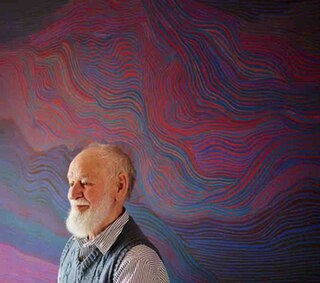
Julian Stanczak was a Polish-born American painter and printmaker who was one of the central figures in the Op art movement in the U.S. during the 1960s and 1970s. Described as an artist whose work "evinced a tremendous geometric inventiveness", Stanczak is primarily known for his polychromatic abstract paintings made using acrylic on canvas which rely on an interplay between geometric forms and lines.
A Master of Fine Arts is a terminal degree in fine arts, including visual arts, creative writing, graphic design, photography, filmmaking, dance, theatre, other performing arts and in some cases, theatre management or arts administration. It is a graduate degree that typically requires two to three years of postgraduate study after a bachelor's degree, though the term of study varies by country or university. Coursework is primarily of an applied or performing nature, with the program often culminating in a thesis exhibition or performance. The first university to admit students to the degree of Master of Fine Arts was the University of Iowa in 1940.

Daniel Rhodes was an American artist, known as a ceramic artist, muralist, sculptor, author and educator. During his 25 years (1947–1973) on the faculty at the New York State College of Ceramics at Alfred University, in Alfred, New York, he built an international reputation as a potter, sculptor and authority on studio pottery.

Mac Adams is a British artist.
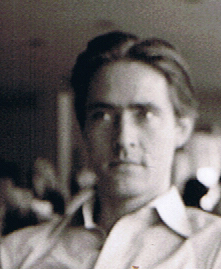
Jeremy Gilbert-Rolfe is a British-born American painter, art critic, theorist, and educator, born in Royal Tunbridge Wells, United Kingdom. In 1968, he moved to the United States. Gilbert-Rolfe holds several degrees, including a National Diploma in Painting from Tunbridge Wells School of Art (1965), an ATC from the London University Institute of Education (1967), and an MFA from Florida State University (1970). His work is in the permanent collections of the Albright-Knox Gallery of Art, Buffalo, NY; The Getty Study Center, Los Angeles; the Hammer Museum, Los Angeles; the Los Angeles County Museum of Art; the Museum of Contemporary Art, Los Angeles; the Museum of Contemporary Art, North Miami; the Frederick R. Weisman Foundation in Los Angeles and Minneapolis; the Whitney Museum of American Art, New York; and other public, corporate and private collections.

Karl Stanley Benjamin was an American painter of vibrant geometric abstractions, who rose to fame in 1959 as one of four Los Angeles–based Abstract Classicists and subsequently produced a critically acclaimed body of work that explores a vast array of color relationships. Working quietly at his home in Claremont, CA, he developed a rich vocabulary of colors and hard-edge shapes in masterful compositions of tightly balanced repose or high-spirited energy. At once intuitive and systematic, the artist was, in the words of critic Christopher Knight, "a colorist of great wit and inventiveness."
Raymond Parker (1922-1990) was an Abstract expressionist painter who also is associated with Color Field painting and Lyrical Abstraction. Ray Parker was an influential art teacher and an important Color Field painter and an instrumental figure in the movement coined by Clement Greenberg called Post-Painterly Abstraction.

Benjamin Francis Laposky was an American mathematician, artist and draftsman from Cherokee, Iowa. He has been credited with making the first computer graphics, utilizing an oscilloscope as the creation medium for abstract art. In 1953 he released what he called "Oscillons" along with a corresponding thesis entitled "Electronic Abstractions" via a gallery exhibition of fifty pictures of the same name at Sanford Museum in Cherokee. Laposky is often credited as the pioneer for electronic art, more specifically in the analog vector medium.
Stephen Westfall is an American painter, critic, and professor at Rutgers University and Bard College.
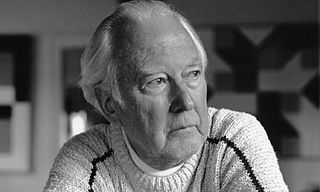
Frederick Hammersley was an American abstract painter. His participation in the 1959 Four Abstract Classicists exhibit secured his place in art history.
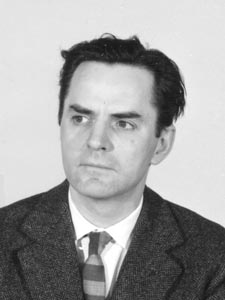
Alfred Russell was an artist who was a member of the early New York school of Abstract Expressionism. He exhibited in Paris and New York along with such well known painters as Willem de Kooning, Jackson Pollock, Ad Reinhardt and Mark Rothko. Later in life, Russell, disillusioned with abstraction, turned to figurative painting, with inspiration from the classical world.
Ann Pibal is an American painter who makes geometric compositions using acrylic paint on aluminum panel. The geometric intensity is one of the key characteristics that defines her paintings.
Craig Stockwell is a visual artist who paints large, colorful, abstract paintings. He served (2013-20) as the Director of the MFA in Visual Arts program at the New Hampshire Institute of Art.
Mary Obering was an American painter focusing mainly on geometric abstraction.

Rodney Carswell is an American abstract artist. He first gained recognition for human-scaled, geometric paintings that feature exposed, projected support structures, creating interplay between sculptural presence and richly painted pictorial surfaces. His recent paintings eschew the superstructures and evoke a greater sense of immediacy, playfulness, and narrative. Critics often describe Carswell's work as uncanny, elusive or quirky, for its tendency to negotiate "in-between" spaces and embrace contradictions such as order and instability, intention and accident, or back and front. Employing irregularly shaped canvasses, thick supports, and openings or holes that reveal the stretcher construction and walls behind them, works like 3 (1994) often occupy a place between painting and sculpture. In a similar way, Carswell uses the modernist languages of Minimalism, Suprematism and Constructivism, yet eludes those categories with postmodern allusions to architecture, the body and spiritual iconography, and with his process-oriented, "hand-made" surfaces. In his essay for Carswell's mid-career retrospective at Chicago's Renaissance Society, Los Angeles Times critic David Pagel suggested that his understated paintings worked their way into one's consciousness in a "supple, somewhat unsettling manner" that achieves a subtle, but lingering shift in perception.
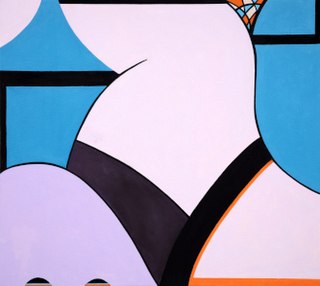
Amanda Church is an American artist known for abstract paintings that reference the human figure and other discernible elements. Her works straddle representational and formalist art traditions, suggesting recognizable body parts, objects, and perspectival elements in an otherwise abstract field. Church's distinctive use of contrasting style elements has been consistently noted by critics such as Hyperallergic's Cora Fisher, who described Church's work as "whimsically overruling the left-right brain dichotomy as well as the traditionally gendered axis that divides geometric and decorative art." Church received a Guggenheim Fellowship in 2015 and a Pollock-Krasner Foundation grant in 2017, among other awards. Her work has been covered in publications such as The New York Times, The Boston Globe, ARTnews, Hyperallergic and Forbes Magazine. Her paintings have been exhibited in major U.S. cities as well as internationally, in galleries and museums such as the Brooklyn Museum of Art and the Aldrich Museum. She lives and works in New York.
William Page Reimann is an American sculptor and arts educator, known for his large plexiglas and steel sculptures, stonework, metalwork, and figurative graphite and ink drawings. He was among the handful of "pioneering" sculptors who brought plastic materials to the New York art scene in the 1960s. In stone, his notable public works include the Radnor Gateway Project for the Blue Route in Radnor, PA, and the twenty-four granite panel series of the Piers Park Commons Pavilion in East Boston, MA.












